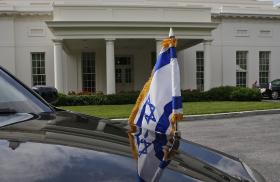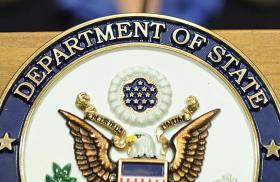
- Policy Analysis
- PolicyWatch 4068
After the "Hammer": Postwar Opportunities and Risks for U.S. Policy in the Middle East

The objectives of Operation Midnight Hammer aligned with the broader U.S. goals of curbing Iranian threats and stabilizing the Middle East—but military force alone will not produce those outcomes.
On June 30, The Washington Institute held a virtual Policy Forum with Robert Satloff, Mona Yacoubian, and Richard Nephew. Satloff is the Institute’s Segal Executive Director and Howard P. Berkowitz Chair in U.S. Middle East Policy. Yacoubian directs the Middle East Program at the Center for Strategic and International Studies. Nephew is the Institute’s Bernstein Adjunct Fellow and former U.S. deputy special envoy for Iran. The following is a rapporteur’s summary of their remarks.
Robert Satloff
The Middle East has now entered a new era of normalized interstate conflict, triggered by Iran’s direct missile and drone attacks on Israel last year, which set the predicate for the recent U.S. and Israeli bombing of Iran’s nuclear sites. Shifting to direct interstate attack represents a major strategic blunder for Iran, exposing its national assets and citizens to external attack for the first time since the Iran-Iraq War.
The attack on Iran is a watershed for U.S. policy, redefining red lines for potential U.S. military action against the Islamic Republic. Previously, there was friction between the United States and Israel over their respective thresholds for military operations to prevent Iran from developing a nuclear weapon, but the Trump administration’s decision to complement Israel’s attacks effectively closed this gap. The result is that Washington now “owns” the policy of prevention.
At the same time, the nature of U.S.-Israel strategic relations is evolving rapidly. While America has long undertaken military operations in Israel’s defense, the attack on Iran was its first offensive action in coordination with Israel. This new era of strategic relations requires new ground rules.
Two realities can be true at the same time: on one hand, the U.S. and Israeli strikes dealt a massive blow to Iran’s nuclear program; on the other hand, Iran likely retains the capability to produce a crude nuclear device relatively quickly, and it probably has increased incentive to do so. For Washington, therefore, the goal should be to translate military success into political achievement as quickly as possible. This means reaching a diplomatic agreement in which Iran forswears enrichment, discloses all secret nuclear facilities, transfers its stockpile of high-enriched uranium to international control, and accepts intrusive inspections, among other things. In the end, further U.S. military action may be required to convince Tehran that an agreement will safeguard its regime more than a swift breakout toward a nuclear weapon would.
Mona Yacoubian
A direct military confrontation between Iran and Israel represents a nightmare scenario for the Middle East, coming at a moment when the region is shifting from the old order of the past two decades to a new order in which the Gulf states constitute the new center of gravity. The highly telegraphed nature of Iran’s recent retaliatory attack on Qatar’s al-Udeid Air Base allowed time to evacuate personnel and avoid casualties, reflecting years of efforts by the Gulf states to deepen communication and build rapprochement with Iran. Yet this moment also reveals a worrying trend: interstate conflict is becoming normalized, which is deeply at odds with the interests and priorities of the Gulf states.
De-escalation is an existential imperative for these states because their economies hinge on stability. They have long believed that integrating rather than isolating Iran is the more sustainable strategy. Their experience in pursuing isolation—such as before the 2019 attack on Saudi oil facilities, which saw no U.S. response—only reinforced this conviction. The Gulf states recognize that a cornered Iran is prone to lash out, often at their direct expense. This strategic calculation has driven countries such as Oman and Qatar to take active roles as mediators between the United States and Iran, seeking creative paths toward de-escalation and diplomatic resolution.
There is now a historic opportunity to address not only Iran’s nuclear ambitions, but also its broader regional role through comprehensive agreements rather than continued military strikes. The Gulf states also understand that lasting peace will require a permanent ceasefire in Gaza to enable broader Arab cooperation with Israel, as well as the cessation of Israeli strikes in Lebanon, which risk prolonging instability. Normalizing interstate conflict as the new regional norm is dangerous for all states, including Israel and Iran alike.
For the United States, this moment demands a significant diplomatic commitment. Relying solely on military pressure risks pushing Iran to accelerate efforts to build a crude nuclear device while undermining broader regional stability. Instead, Washington should leverage the resources, mediation channels, and influence of its Arab allies to support a vision of a Middle East that is stable, prosperous, and inclusive. Diplomatic engagement remains the only path likely to deliver lasting agreements that address longstanding challenges in the Israeli-Palestinian arena, Iran, Lebanon, and Syria.
If successful, this diplomatic strategy could transform the region, turning decades of conflict into a future defined by cooperation. Acknowledging President Trump’s penchant for disruption and unpredictability, it may be helpful to appeal to his ego and aspirations for a Nobel Peace Prize to ensure sustained U.S. investment in the region and pursuit of a grand bargain. Rather than sliding further into conflict, now is the time to double down on diplomacy.
Richard Nephew
The U.S. and Israeli strikes inflicted significant damage on Iran’s nuclear program, destroying large numbers of centrifuges at sites like Fordow and Natanz while hampering the regime’s ability to rapidly achieve a nuclear breakout. Yet critical questions remain about whether Iran retains residual equipment, expertise, and, crucially, 400 kilograms of 60 percent enriched uranium, which could still enable it to produce nuclear weapons quickly. While the strikes achieved important tactical gains, the next challenge is to solidify these achievements through a durable diplomatic solution—an outcome made more complicated by the distrust that military action creates between parties now expected to negotiate.
A credible nuclear deal would likely provide Iran with sanctions relief, but it is unclear whether Tehran would accept significant nuclear constraints and what form verification could take. Verifying the destruction of Iran’s stock of enriched uranium or its elimination by other means is central—without such assurance, officials would have to assume the material still exists and could fuel a breakout attempt. To move forward, negotiators need to clearly define U.S.-Iran ceasefire terms, identify potential breaches (such as activity at Fordow or the excavation of tunnels), and establish rigorous inspection mechanisms and triggers for future use of force.
The question of UN sanctions “snapback” is complex. The United States cannot unilaterally trigger the snapback mechanism because it withdrew from the 2015 Joint Comprehensive Plan of Action without doing so; therefore, the agreement of France, Germany, or the United Kingdom is required to reimpose UN Security Council sanctions. Recently, the International Atomic Energy Agency’s Board of Governors once again found Iran in noncompliance with its treaty obligations, and formally reporting this to the Security Council could serve as a basis for snapback. If snapback occurs, Iran may respond by withdrawing from the Nuclear Nonproliferation Treaty and further restricting IAEA inspections. While UN sanctions mainly target proliferation concerns rather than Iran’s broader economy, they hold greater value post-strike as Iran seeks components to rebuild its nuclear and missile programs.
This summary was prepared by Sarah Boches. The Policy Forum series is made possible through the generosity of the Florence and Robert Kaufman Family.





